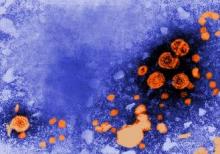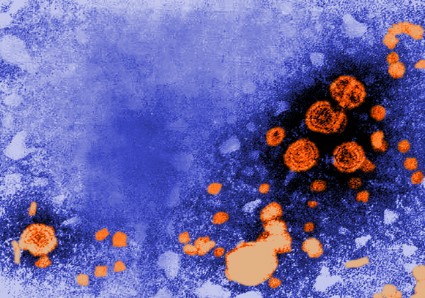User login
BOSTON – In patients who had chronic hepatitis B infections and documented lamivudine resistance, tenofovir with or without emtricitabine produced high rates of viral suppression with no detectable resistance over 2 years.
In a phase IIIb randomized study, 89% of lamivudine-resistant patients with HBV who were randomly assigned to receive tenofovir (Viread) alone met the primary end point of HBV DNA below 400 copies/mL, compared with 86% of those assigned to a tenofovir/emtricitabine (Emtriva) combination, in an intention-to-treat analysis, Dr. Scott Fung, assistant professor of hepatology at the University of Toronto, reported at the annual meeting of the American Association for the Study of Liver Diseases.
"Tenofovir monotherapy was just as safe and effective as combination therapy, suggesting that monotherapy alone was sufficient for treatment of hepatitis B," Dr. Fung said.
In addition to the high rate of viral resistance, tenofovir was associated with normalization of ALT levels in a majority of patients, and with no emergent viral resistance, he said.
The investigators enrolled 280 patients who carried virus with lamivudine-resistant mutations, were viremic (HBV DNA greater than 103/IU per mL), and were still on lamivudine until the day of randomization. Current or prior treatment with adefovir (Hepsera) was allowed as long as the patient had received less than 48 total weeks of therapy.
A total of 133 patients who were assigned to receive tenofovir 300 mg daily completed 96 weeks of treatment and were thus available for analysis, as were 125 of those assigned to emtricitabine/tenofovir in a fixed-dose combination.
As noted before, the rates of HBV DNA below 400 copies/mL were 89% for the monotherapy arm and 86% for the combination in an analysis that considered missing data as treatment failure. When missing data were excluded from an on-treatment analysis, however, the respective rates were 96% and 95%.
Using a lower cutoff point, less than 169 copies/mL, the respective rates at 96 weeks were 86% and 84%.
In all, 70% of patients in each group had normal ALT levels at 96 weeks, and among patients with abnormally high levels at baseline nearly two-thirds in each group had normalization of ALT during the study.
The HBV e-antigen loss rate was modest, at 15% of patients on tenofovir alone and 13% on the combination. HBeAg seroconversion occurred in 11% and 10%, respectively.
Among 18 patients who qualified for genotypic resistance testing at their last on-treatment visit, there were no viral isolates demonstrating tenofovir resistance, Dr. Fung said.
There were three deaths during the study: one from gastrointestinal hemorrhage in a patient in the monotherapy group and two – one from cardiac arrest and sepsis in a patient with hepatocellular carcinoma and one from bronchopneumonia – in the combination group. The deaths were judged to be unrelated to study treatment.
There was only one serious treatment-related adverse event, occurring in the combination group (the event was unspecified), and only three patients discontinued because of adverse events – one in the monotherapy arm and two in the combination group. Five patients on tenofovir alone and four on the combination had creatinine clearance less than 50 mL/min at study end; these patients all had low baseline creatinine clearance levels, ranging from 41 to 69 mL/min, Dr. Fung noted.
The authors also looked at bone mineral density levels at baseline and at study end in 239 patients for who dual-energy x-ray absorptiometry data were available. At baseline, 33% of patients were determined to have osteopenia and 7% to have osteoporosis on spine scans and 22% and 1.3%, respectively, on hip scans. Repeat scans at 96 weeks showed that the majority of patients had a reduction in bone mineral density of about 22%, a decline that was considered not clinically significant, he said.
The study was funded by Gilead Sciences. Dr. Fung disclosed receiving grant/research support and speaking/teaching fees from the company.
BOSTON – In patients who had chronic hepatitis B infections and documented lamivudine resistance, tenofovir with or without emtricitabine produced high rates of viral suppression with no detectable resistance over 2 years.
In a phase IIIb randomized study, 89% of lamivudine-resistant patients with HBV who were randomly assigned to receive tenofovir (Viread) alone met the primary end point of HBV DNA below 400 copies/mL, compared with 86% of those assigned to a tenofovir/emtricitabine (Emtriva) combination, in an intention-to-treat analysis, Dr. Scott Fung, assistant professor of hepatology at the University of Toronto, reported at the annual meeting of the American Association for the Study of Liver Diseases.
"Tenofovir monotherapy was just as safe and effective as combination therapy, suggesting that monotherapy alone was sufficient for treatment of hepatitis B," Dr. Fung said.
In addition to the high rate of viral resistance, tenofovir was associated with normalization of ALT levels in a majority of patients, and with no emergent viral resistance, he said.
The investigators enrolled 280 patients who carried virus with lamivudine-resistant mutations, were viremic (HBV DNA greater than 103/IU per mL), and were still on lamivudine until the day of randomization. Current or prior treatment with adefovir (Hepsera) was allowed as long as the patient had received less than 48 total weeks of therapy.
A total of 133 patients who were assigned to receive tenofovir 300 mg daily completed 96 weeks of treatment and were thus available for analysis, as were 125 of those assigned to emtricitabine/tenofovir in a fixed-dose combination.
As noted before, the rates of HBV DNA below 400 copies/mL were 89% for the monotherapy arm and 86% for the combination in an analysis that considered missing data as treatment failure. When missing data were excluded from an on-treatment analysis, however, the respective rates were 96% and 95%.
Using a lower cutoff point, less than 169 copies/mL, the respective rates at 96 weeks were 86% and 84%.
In all, 70% of patients in each group had normal ALT levels at 96 weeks, and among patients with abnormally high levels at baseline nearly two-thirds in each group had normalization of ALT during the study.
The HBV e-antigen loss rate was modest, at 15% of patients on tenofovir alone and 13% on the combination. HBeAg seroconversion occurred in 11% and 10%, respectively.
Among 18 patients who qualified for genotypic resistance testing at their last on-treatment visit, there were no viral isolates demonstrating tenofovir resistance, Dr. Fung said.
There were three deaths during the study: one from gastrointestinal hemorrhage in a patient in the monotherapy group and two – one from cardiac arrest and sepsis in a patient with hepatocellular carcinoma and one from bronchopneumonia – in the combination group. The deaths were judged to be unrelated to study treatment.
There was only one serious treatment-related adverse event, occurring in the combination group (the event was unspecified), and only three patients discontinued because of adverse events – one in the monotherapy arm and two in the combination group. Five patients on tenofovir alone and four on the combination had creatinine clearance less than 50 mL/min at study end; these patients all had low baseline creatinine clearance levels, ranging from 41 to 69 mL/min, Dr. Fung noted.
The authors also looked at bone mineral density levels at baseline and at study end in 239 patients for who dual-energy x-ray absorptiometry data were available. At baseline, 33% of patients were determined to have osteopenia and 7% to have osteoporosis on spine scans and 22% and 1.3%, respectively, on hip scans. Repeat scans at 96 weeks showed that the majority of patients had a reduction in bone mineral density of about 22%, a decline that was considered not clinically significant, he said.
The study was funded by Gilead Sciences. Dr. Fung disclosed receiving grant/research support and speaking/teaching fees from the company.
BOSTON – In patients who had chronic hepatitis B infections and documented lamivudine resistance, tenofovir with or without emtricitabine produced high rates of viral suppression with no detectable resistance over 2 years.
In a phase IIIb randomized study, 89% of lamivudine-resistant patients with HBV who were randomly assigned to receive tenofovir (Viread) alone met the primary end point of HBV DNA below 400 copies/mL, compared with 86% of those assigned to a tenofovir/emtricitabine (Emtriva) combination, in an intention-to-treat analysis, Dr. Scott Fung, assistant professor of hepatology at the University of Toronto, reported at the annual meeting of the American Association for the Study of Liver Diseases.
"Tenofovir monotherapy was just as safe and effective as combination therapy, suggesting that monotherapy alone was sufficient for treatment of hepatitis B," Dr. Fung said.
In addition to the high rate of viral resistance, tenofovir was associated with normalization of ALT levels in a majority of patients, and with no emergent viral resistance, he said.
The investigators enrolled 280 patients who carried virus with lamivudine-resistant mutations, were viremic (HBV DNA greater than 103/IU per mL), and were still on lamivudine until the day of randomization. Current or prior treatment with adefovir (Hepsera) was allowed as long as the patient had received less than 48 total weeks of therapy.
A total of 133 patients who were assigned to receive tenofovir 300 mg daily completed 96 weeks of treatment and were thus available for analysis, as were 125 of those assigned to emtricitabine/tenofovir in a fixed-dose combination.
As noted before, the rates of HBV DNA below 400 copies/mL were 89% for the monotherapy arm and 86% for the combination in an analysis that considered missing data as treatment failure. When missing data were excluded from an on-treatment analysis, however, the respective rates were 96% and 95%.
Using a lower cutoff point, less than 169 copies/mL, the respective rates at 96 weeks were 86% and 84%.
In all, 70% of patients in each group had normal ALT levels at 96 weeks, and among patients with abnormally high levels at baseline nearly two-thirds in each group had normalization of ALT during the study.
The HBV e-antigen loss rate was modest, at 15% of patients on tenofovir alone and 13% on the combination. HBeAg seroconversion occurred in 11% and 10%, respectively.
Among 18 patients who qualified for genotypic resistance testing at their last on-treatment visit, there were no viral isolates demonstrating tenofovir resistance, Dr. Fung said.
There were three deaths during the study: one from gastrointestinal hemorrhage in a patient in the monotherapy group and two – one from cardiac arrest and sepsis in a patient with hepatocellular carcinoma and one from bronchopneumonia – in the combination group. The deaths were judged to be unrelated to study treatment.
There was only one serious treatment-related adverse event, occurring in the combination group (the event was unspecified), and only three patients discontinued because of adverse events – one in the monotherapy arm and two in the combination group. Five patients on tenofovir alone and four on the combination had creatinine clearance less than 50 mL/min at study end; these patients all had low baseline creatinine clearance levels, ranging from 41 to 69 mL/min, Dr. Fung noted.
The authors also looked at bone mineral density levels at baseline and at study end in 239 patients for who dual-energy x-ray absorptiometry data were available. At baseline, 33% of patients were determined to have osteopenia and 7% to have osteoporosis on spine scans and 22% and 1.3%, respectively, on hip scans. Repeat scans at 96 weeks showed that the majority of patients had a reduction in bone mineral density of about 22%, a decline that was considered not clinically significant, he said.
The study was funded by Gilead Sciences. Dr. Fung disclosed receiving grant/research support and speaking/teaching fees from the company.
AT THE ANNUAL MEETING OF THE AMERICAN ASSOCIATION FOR THE STUDY OF LIVER DISEASES
Major Finding: In a phase IIIb randomized study, 89% of lamivudine-resistant patients with HBV who received tenofovir alone met the primary end point of HBV DNA below 400 copies/mL, compared with 86% of those given a tenofovir/emtricitabine combination.
Data Source: A randomized, double-blind phase IIIb study
Disclosures: The study was funded by Gilead Sciences. Dr. Fung disclosed receiving grant/research support and speaking/teaching fees from the company.

